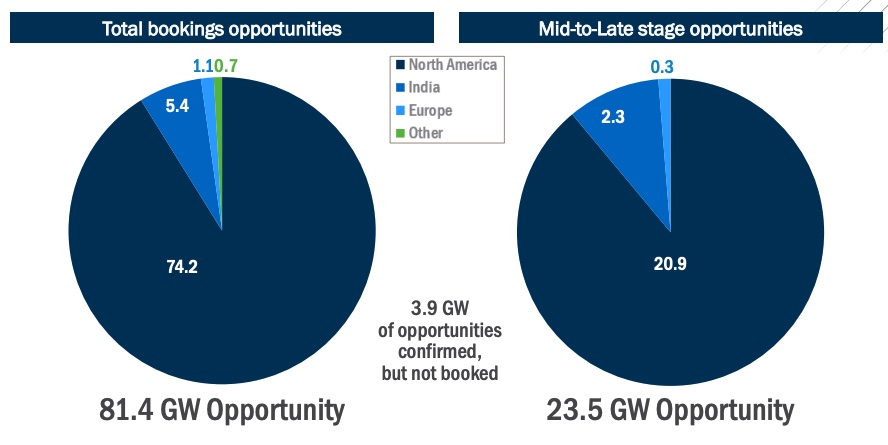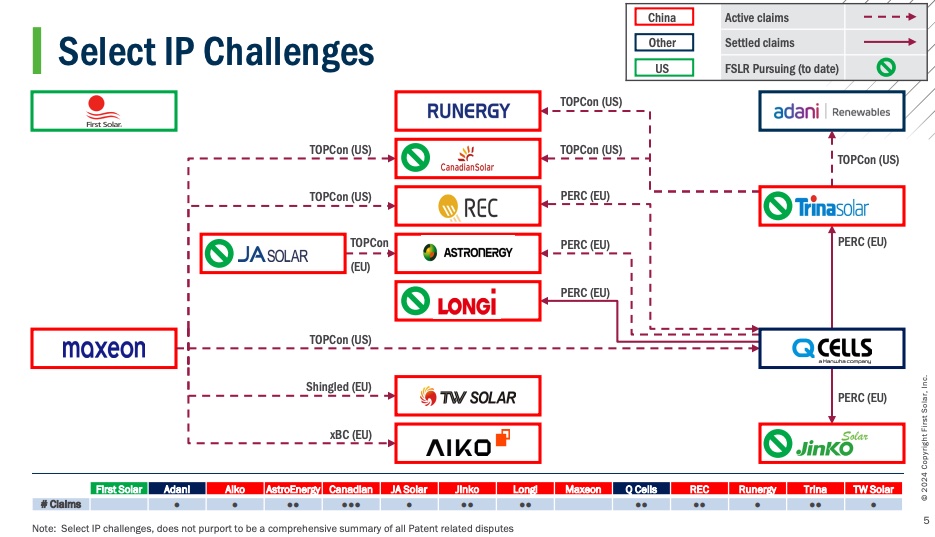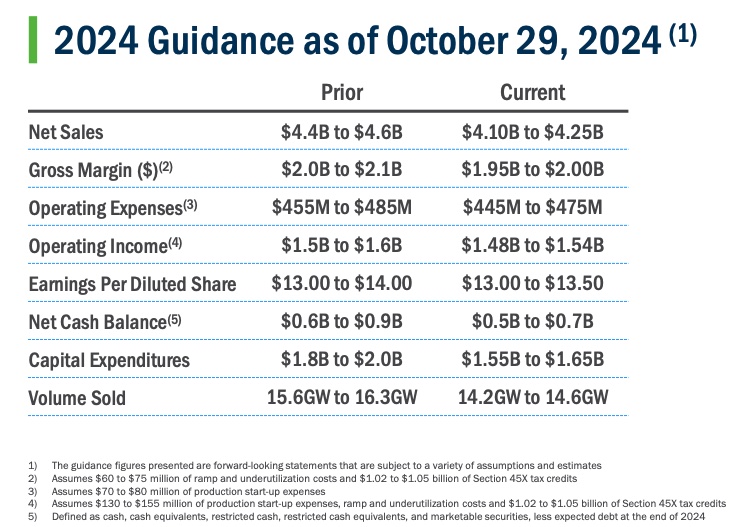
First Solar executives said Chinese dumping and alleged patent infringements are among concerns for the solar panel maker. (Source: Shutterstock.com)
First Solar grew its year-to-date bookings to 4 gigawatts (GW), despite facing Chinese dumping and alleged patent infringements by competitors, the company said during its latest quarterly earnings report.
The solar panel manufacturer is overcoming hurdles while targeting more than 81.4 GW of potential global booking opportunities. Most of those opportunities are in the U.S., where installed solar capacity continues to soar—driven by supportive federal policies, falling costs and the push to lower emissions. However, like other energy players, the company is contending with the impact of longer interconnection delays.
“As we approach the end of 2024, we remain pleased with the progress made across our business navigating against the backdrop of industry volatility and political uncertainty with a continuous focus on balancing growth, profitability, and liquidity,” First Solar CEO Mark Widmar said Oct. 29 during an earnings call.
He added, “Our story is about the value of long-term strategic decision-making, underpinned by differentiated technology and business model, which endeavors to drive value creation for our shareholders and partners. We expect that this disciplined long-term approach will allow us to work through the outcomes of the upcoming U.S. elections as well as continued volatility across the solar manufacturing industry.”
Financial highlights
First Solar, the biggest solar panel maker in the U.S., reported that its third-quarter 2024 profit increased 16.6% to about $313 million, compared to a year earlier, helped by strong prices in the U.S. market after additional tariffs were imposed on non-U.S. made panels.
However, net sales for the quarter dropped to about $888 million, down about 10.8%.
The drop was attributed to a 12% decrease in the volume of megawatts (MW) sold and an increase in the company’s Series 7 product warranty liability, which was offset in part by expected payments concerning contract terminations in the U.S. and India, CFO Alex Bradley said.
First Solar reported a $50 million product warranty charge related to manufacturing issues, related to initial production of its new Series 7 product. The issue, which the company said has been addressed, involved “variability in the effectiveness of the glass cleaning process at the beginning of our production line and an error in our process of predicting the engineering performance margin,” Widmar said.
The company lowered its 2024 net sales guidance to between $4.10 billion and $4.25 billion ($4.17 billion at the midpoint). Compared to previous guidance of $4.4 billion to $4.6 billion ($4.5 billion at the midpoint), the revision represents a 7% drop in sales. Gross margins, operating income, net cash balance, capex and volumes sold also saw downward revision.
Chinese dumping
The results missed analysts’ expectations. Jefferies pointed out several headwinds.
“The dumping of Chinese modules in India has led to lower ASPs [average selling prices], resulting in contract termination with customers,” analysts said in a note Oct. 30. “In 3Q, FSLR [First Solar] enforced termination rights on one contract in the U.S. (Plug Power) and two contracts in India, for which it received $72.3 [million]. The company expects to litigate to receive the balance owed to them.”
First Solar executives said they are still concerned about Chinese dumping in India.
China has been flooding the market with cheap solar panels, which has led to an oversupply, price collapse and tariff increases, including in the U.S. where domestic capacity is being built up.
Authorities in India, where First Solar operates, have initiated an anti-dumping investigation into solar cell imports from China, Bradley said.
“However, despite this investigation, domestic India ASPs remain depressed as a function of this dumping behavior, and as reflected by the approximately $0.19 per watt ASP for our recent India bookings,” he said. “With such artificially depressed ASPs in the India market, we see the updated Safe Harbor guidance for the IRA [Inflation Reduction Act] domestic content bonus released in May 2024, providing us with an opportunity to shift India production from fixed tilt to tracker product and ship a portion of our future Indian manufactured product into the U.S. market at higher ASPs.”

Patent concerns
First Solar is also taking steps to protect its intellectual property, saying it believes several other companies are infringing on its solar technology.
“Since our July announcement regarding First Solar’s TOPCon patent portfolio, we have advanced our investigation into several leading crystalline silicon solar manufacturers for potential infringement of our patents,” Widmar said. “The result of these efforts has enhanced our conviction that we possess fundamentally valid and enforceable patents in relation to TOPCon cell technology. To that end, we have recently begun sending letters to various solar manufacturers.”
He added the company is in negotiations with multiple interested parties concerning rights to its TOPCon patent portfolio.
The company is among several manufacturers, including Trina Solar, taking steps to protect solar panel IP.

Analysts’ take
Despite the earnings miss, analysts remained positive while awaiting the company’s future moves in the U.S. and the impact of the upcoming election.
Evecore’s key takes:
“1) the company will continue to prioritize customers with long-term contracts, 2) First Solar reached record production again in 3Q24 at 3.8 GW vs previous record of 3.7 GW in 2Q24, and 3) we remain positive on FSLR’s story and will continue to assess further political implications after the U.S. elections takes place next week,” it said in a note Oct. 29.
Jefferies analysts pointed out “unique and understated twists” from the third-quarter call: “The idea that [management] could add new assembly capacity in the U.S. such that it could export ‘cell only’ type product from SE Asia and India and assemble in the U.S. to add further ‘points’ towards domestic contents.”

Solar panel manufacturers are incentivized with tax credits in the U.S. to boost production domestically. These include the Inflation Reduction Act’s 45X credit for manufacturers of solar, wind and battery components.
“This could result in margin accretion, but we wait for more clarity before underwriting these in our estimates. Total extent of MWs for new line is key,” Jefferies said.
Recommended Reading
LS Power Completes Acquisition of Algonquin Power’s Renewables Unit
2025-01-09 - With the transaction’s closure on Jan. 8, LS Power formed Clearlight Energy to manage the acquired renewable energy assets.
On The Market This Week (Jan. 20, 2025)
2025-01-24 - Here is a roundup of marketed oil and gas interests in the Delaware Basin, Midcontinent and Bakken from select sellers.
Allete Gets OK From FERC for $6.2B Sale to Canada Pension Plan, GIP
2024-12-20 - Allete Inc. announced its acquisition by the Canada Pension Plan Investment Board and Global Infrastructure Partners in May.
Shell Completes Deal to Buy Power Plant in Rhode Island
2025-01-24 - Shell has completed its previously announced acquisition to buy a 609-megawatt combined cycle gas turbine power plant in Rhode Island from RISEC Holdings.
TotalEnergies Pauses Business with Adani, Says it was Not Aware of US Investigation
2024-11-25 - French oil major TotalEnergies SE was not informed of a U.S. investigation into possible bribery and corruption at Adani Green Energy Ltd., it said on Nov. 25, adding it will stop financial contributions to its Adani Group investments following last week's indictment.
Comments
Add new comment
This conversation is moderated according to Hart Energy community rules. Please read the rules before joining the discussion. If you’re experiencing any technical problems, please contact our customer care team.





